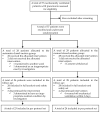Clinical Efficacy and Safety of an Automatic Closed-Suction System in Mechanically Ventilated Patients with Pneumonia: A Multicenter, Prospective, Randomized, Non-Inferiority, Investigator-Initiated Trial
- PMID: 38893595
- PMCID: PMC11172224
- DOI: 10.3390/diagnostics14111068
Clinical Efficacy and Safety of an Automatic Closed-Suction System in Mechanically Ventilated Patients with Pneumonia: A Multicenter, Prospective, Randomized, Non-Inferiority, Investigator-Initiated Trial
Abstract
Endotracheal suctioning is an essential but labor-intensive procedure, with the risk of serious complications. A brand new automatic closed-suction device was developed to alleviate the workload of healthcare providers and minimize those complications. We evaluated the clinical efficacy and safety of the automatic suction system in mechanically ventilated patients with pneumonia. In this multicenter, randomized, non-inferiority, investigator-initiated trial, mechanically ventilated patients with pneumonia were randomized to the automatic device (intervention) or conventional manual suctioning (control). The primary efficacy outcome was the change in the modified clinical pulmonary infection score (CPIS) in 3 days. Secondary outcomes were the frequency of additional suctioning and the amount of secretion. Safety outcomes included adverse events or complications. A total of 54 participants, less than the pre-determined number of 102, were enrolled. There was no significant difference in the change in the CPIS over 72 h (-0.13 ± 1.58 in the intervention group, -0.58 ± 1.18 in the control group, p = 0.866), but the non-inferiority margin was not satisfied. There were no significant differences in the secondary outcomes and safety outcomes, with a tendency for more patients with improved tracheal mucosal injury in the intervention group. The novel automatic closed-suction system showed comparable efficacy and safety compared with conventional manual suctioning in mechanically ventilated patients with pneumonia.
Keywords: critical care; endotracheal suctioning; intensive care unit; mucosal secretions.
Conflict of interest statement
The authors declare no conflicts of interest. The funder had no role in the collection, analysis, and interpretation of data and writing of this manuscript. The device supporter played no role in the collection, analysis, and interpretation of the data or writing of this manuscript.
Figures


References
-
- American Association for Respiratory Care AARC Clinical Practice Guidelines. Endotracheal suctioning of mechanically ventilated patients with artificial airways 2010. Respir. Care. 2010;55:758–764. - PubMed
-
- Chen W., Hu S., Liu X., Wang N., Zhao J., Liu P., Chen K., Hu J. Intensive care nurses’ knowledge and practice of evidence-based recommendations for endotracheal suctioning: A multisite cross-sectional study in Changsha, China. BMC Nurs. 2021;20:186. doi: 10.1186/s12912-021-00715-y. - DOI - PMC - PubMed
Grants and funding
LinkOut - more resources
Full Text Sources

